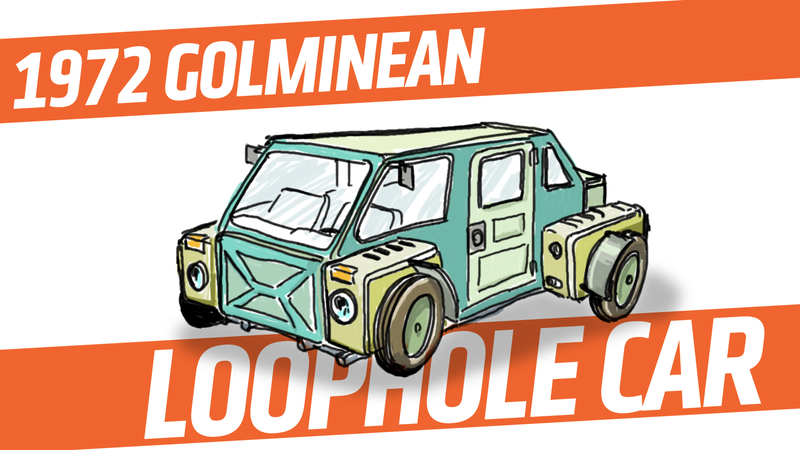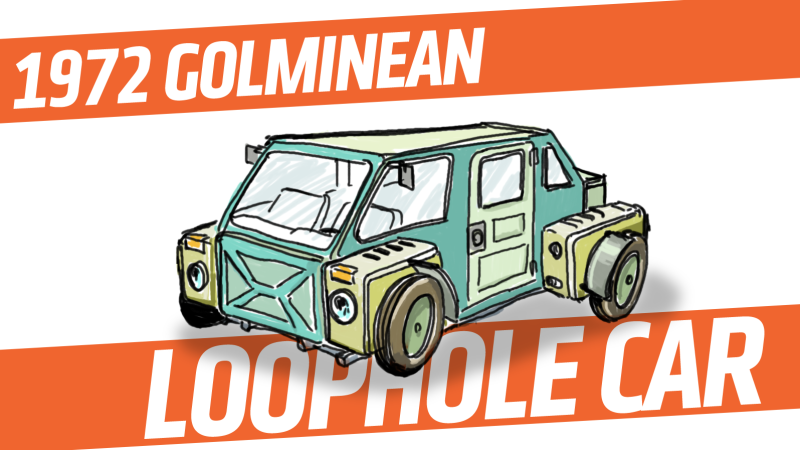
I know it’s been a while, but I think it’s time for another installment of Imaginary Car from an Imaginary Country. Today, I want to tell you about the inspirational people of Golminea, the country forbidden to build cars, and the cars that they built.
Golminea was a small but quite prosperous nation, situated in the plainslands in the middle of the Andes, roughly equidistant between Peru and Ecuador. Golminea was one of several countries to fight against the rise of the Pan-Amazonian Empire, the fiercely Libertario-Socialist state that took over much of South America while the rest of the world was distracted by World War II.
Golminea put up a good fight, but, like the other anti-PanAmaz allies, was eventually conquered and made satellite states of the PanAmaz empire. The PanAmaz economy was unusual in that it was a centrally-planned free-market economy, the operation of which even the Empire’s own economic experts could never really explain.
Before the war, Golminea had a thriving automotive industry, making such legendary cars as the Longriver Anaconda Sport 14 and the very influential Macaw Motors Raindancer series. After they were conquered by the PanAmaz Empire, the Empire decided to punish Golminea for their actions in the war by forbidding any sort of automotive production by any Golminean company.
What was permitted for mass production were three primary industries: aluminum ladders, fiberglass pre-manufactured buildings like sheds, porta-potties, greenhouses, and so on, and potter’s wheels.
Advertisement
Golminea has a long history of earthenwares and pottery, so they had been building motorized potter’s wheels for years. Golminean pottery was also known for making large-scale pots and vessels that were used extensively in the PanAmaz shipping and transport industries, thanks to highly resilient clay/rubber hybrids developed by Golminean potters.
To make these large-scale vessels, Golminean potters developed a powerful, gasoline-fueled potter’s wheel, complete with a protective pneumatic rubber rim around the wheel and an integrated 12V electrical system to operate work lamps:
Advertisement
While these were highly effective heavy-duty potter’s wheels, they were also the key component that allowed Golminea to re-start their automotive industry without technically violating their economic orders from PanAmaz.
Former Golminean automotive engineers worked with leaders from the three main industries to create the plans for a usable car that could be made from four heavy-duty potter’s wheels, a fiberglass shed, and aluminum ladders.
Advertisement
The ladders were used to create a light, sturdy chassis. Onto the chassis was bolted a “greenhouse model” fiberglass shed, with many windows and two side doors, along with a fiberglass storage trunk bolted to the rear. At each corner was mounted a heavy duty potter’s wheel, mounted on its side, with the wheel locked into a position to let it make contact with the ground.
The potter wheel’s electrical systems were interconnected, and steering was accomplished via a skid-steer method using the integrated electrically-actuated brakes on the potter’s wheels. Work lamps became headlights and (suitably fitted with red lenses) taillights, operating lamps became indicators, and the interior was fitted with lawn chairs and controls taken from kitchen appliance parts.
Advertisement
The four potter’s wheels combined gave the car 1000 cc and 60 horsepower, more than enough to give the lightweight car spunky performance. Steering was a little odd until you got used to it, and the only real drawback was the suspension, which mostly consisted of heavy rubber mounting bushings for the four power units.
Even with the inherent shortcomings of the design, the “loophole car,” as it came to be known, proved extremely popular in Golminea. Thanks to a highly corrupt central PanAmaz government, Golminea was able to pay an annual “look away” fee to PanAmaz officials, and since, technically, Golminea was not producing automobiles, no actual conditions were being violated, and the Golmineans were free to keep, um, not making cars.
When the PanAmaz Libertarian-Socialist Empire fell in 1987 as a result of a failure of the crunchberry harvest that was keeping the empire going, General Mills took over the Empire and granted all satellite states their freedom, which allowed Golminea to set up a proper automotive industry once again.
Advertisement
Today Golminea is known in the automotive industry as one of the best places to develop mid-cycle refresh designs, and most Golmineans were happy to get rid of their Loophole Cars as soon as other options were available.
Still, there are a number of Loophole Car collectors, including American actress/singer Bette Midler, who has the largest collection of Golminean pottery and Loophole cars outside of South America.













